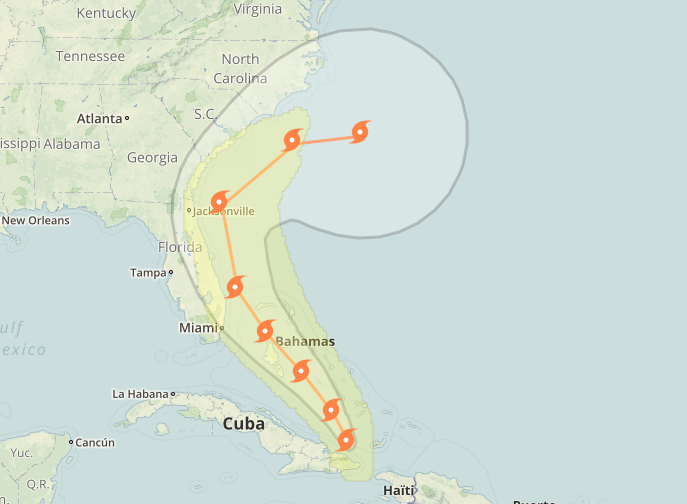As of 8am EDT on October 5th, models for Hurricane Matthew predict a path following the east coast of Florida and up into the Carolinas. The storm initially made made landfall in Haiti on Tuesday as a category 4 hurricane, with top sustained winds near 145 mph. It is is now estimated to be a category 3 storm, according to the Saffir-Simpson scale, with winds topping out at 125 mph, though some slight strengthening is forecast during the next couple of days. Given the storm’s trajectory, the possibility exists for extensive damage along much of the southeastern coast of the US.
Current Storm Behavior
According to the National Hurricane Center, Hurricane Matthew is currently moving north-northwest at roughly 10 mph (17 km/h). This trajectory is expected to continue throughout most of the day Wednesday, however a slight turn to the northwest is expected tonight. If this prediction holds, Matthew will reach the Bahamas on Thursday, with the center of the storm passing directly between Nassau and Andros Island, and then just west of Freeport, Bahamas. Matthew is expected to be very near the east coast of Florida by Thursday evening, sweeping up the coast most of Friday, and potentially reaching Georgia and South Carolina early Saturday morning.
Matthew’s hurricane-force winds over 74 mph extend outward up to 40 miles (65 km) from its center, and tropical-storm-force winds over 39 mph extend outward up to 160 miles (260 km). It is the strongest hurricane in the Caribbean since 2007, when Hurricane Felix (category 5) hit Nicaragua with sustained winds of 160 mph and killed more than 130 people. For reference, 2012’s Hurricane Sandy was a category 3 storm, with winds reaching up to 115 mph, while 2005’s Hurricane Katrina reached category 5 status in the Gulf of Mexico, with winds gusting to 175 mph.

RedZone’s RZAlert Dashboard shows the storm’s predicted path.
Hurricane Matthew Watches and Warnings
According to the NHC, hurricane warnings remained in effect for all of Haiti and portions of Cuba and the Bahamas as of Wednesday morning. At least nine deaths have been reported in those areas. In Florida, a hurricane watch is in effect from Deerfield Beach, 45 miles north of Miami, to the Volusia/Brevard county line near Orlando, encompassing a roughly 200 mile stretch of coastline. Much of the Florida Keys and southern Florida remain under a tropical storm watch.



